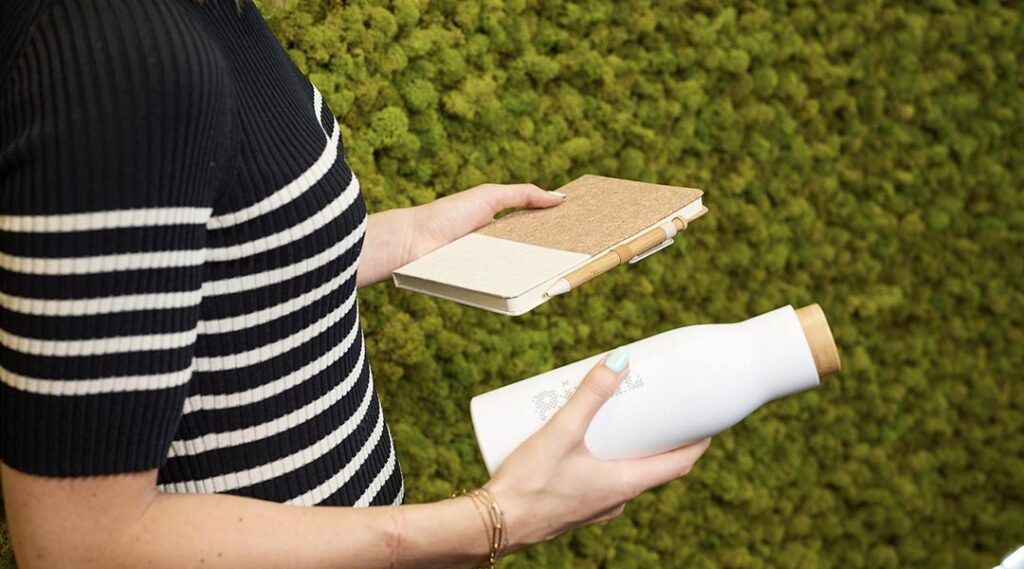
Since the early 2000s, the concept of a carbon footprint has gained increasing importance, particularly following the adoption of the Kyoto Protocol in 1995. This agreement saw 184 countries commit to reducing greenhouse gas emissions.
As a result, businesses also play a crucial role in environmental protection and must take on the challenge of operating more sustainably. Fortunately, small changes can make a big difference.
Discover seven simple actions to help reduce your company’s carbon footprint and contribute to a greener planet.
What Does It Mean to Reduce a Company’s Carbon Footprint?
A carbon footprint measures the amount of greenhouse gases emitted, primarily carbon dioxide (CO2). It can be calculated at the level of a country, an individual, or a company.
Environmental impact, on the other hand, refers to the changes a human activity, product, or process generates in the surrounding ecosystem. Key indicators include:
- – Air: Increased greenhouse effect, atmospheric acidification, ozone layer depletion, and pollutant emissions.
- – Water: Contamination of freshwater and marine sources, damage to aquatic ecosystems, and risks to drinking water quality.
- – Soil: Depletion of natural resources such as fossil fuels and non-renewable minerals.
- – Health: Negative effects on biodiversity and potential health risks for people.
The Challenges Companies Face

The rise in CO₂ emissions is accelerating global warming, and a growing population leads to increasing carbon output each year. While individuals play a vital role in reducing emissions, businesses must also take responsibility.
A company’s environmental impact is not limited to its manufacturing process—it extends across the entire lifecycle of its products and services. Activities such as imports, production, and even digital operations contribute to its carbon footprint.
Impact During Product Manufacturing
Producing goods requires raw materials, energy, and water. Extraction, manufacturing, and storage can generate waste, emissions of harmful substances (such as gases, dust, and noise), and risks of leaks. Every resource used in the creation of a product has an environmental impact.
Impact During Product Use
A product’s impact doesn’t end once it reaches the market. Transport to consumers, energy consumption (especially if it requires continuous power), and harmful substances in its composition can amplify its ecological footprint.
Impact at the End of a Product’s Life Cycle
If a product isn’t recyclable or generates excessive waste, it contributes to pollution and landfill accumulation.
7 Actions to Reduce Your Company’s Carbon Footprint
1. Choose Green Travel Options for Business Trips
The transport sector is a major contributor to CO2 emissions. Air travel remains the most polluting form of transport, while rail is a much greener option.
For business travel, opting for trains or car-sharing helps lower carbon emissions. For commuting, public transport and cycling are more sustainable alternatives.
Tip: Partner with bike rental companies to offer employee discounts, encourage car-sharing groups, or introduce remote working options.
2. Reduce Your Company’s Energy Consumption
Simple practices can significantly cut energy use:
- – Minimising unnecessary lighting, especially during the day.
- – Switching off devices and chargers instead of leaving them on standby.
- – Using heating and cooling systems more efficiently.
Tip: The UK government’s Energy Saving Trust offers advice on reducing business electricity use.
3. Limit Paper Usage
Excessive paper consumption is a major environmental issue. Producing one kilogram of paper requires between 10 and 25 litres of water—equivalent to the recommended daily hydration for 5 to 10 people!
Tip: Print only when necessary, use double-sided and black-and-white printing, and choose recycled paper. Consider giving employees eco-friendly notebooks as corporate gifts.
4. Maintain Your Digital Equipment
Extending the lifespan of digital devices helps reduce waste. Instead of frequently replacing equipment, repairing it is often the more sustainable choice.
Tip: Choose refurbished or second-hand electronics to minimise environmental impact and cut costs.

5. Adopt Sustainable Procurement Policies
Responsible purchasing is a key strategy in reducing carbon footprints. This includes selecting suppliers committed to sustainability and choosing energy-efficient products and services from local providers.
Tip: Before making a purchase, ask whether it’s truly necessary or if a more sustainable alternative exists.
6. Educate Employees on Eco-Friendly Practices
Raising awareness and offering training on sustainability helps create an environmentally conscious company culture.
For example, with digital emissions expected to reach 14% of global greenhouse gases by 2025, businesses should educate employees on reducing their digital footprint. This includes minimising unnecessary emails and optimising cloud storage usage.
Tip: Organise an annual training session on eco-friendly workplace practices.
7. Create an Eco-Friendly Office Kitchen
Providing a well-equipped office kitchen can reduce plastic waste and encourage healthier eating habits.
Installing appliances like microwaves, kettles, and coffee machines encourages employees to bring homemade meals rather than buying pre-packaged food.
Implementing an efficient waste separation system is also crucial. Recycling stations should cover:
- – Paper, cardboard, plastic, glass, and metal.
- – Electronics and batteries.
- – Food waste (for composting).
- – Ink cartridges and light bulbs.
Tip: Provide reusable tableware—plates, cutlery, mugs, and glasses—to cut down on single-use plastics.
Bonus Tip: Add Plants to Your Office
Office plants don’t just look great—they improve air quality by absorbing pollutants and producing oxygen.
They also:
- – Boost employee well-being.
- – Reduce stress levels.
- – Enhance concentration.
Studies show that green office spaces improve productivity and create a more pleasant work environment. Some of the best air-purifying plants include pothos, ficus, and spider plants.
Conclusion
Reducing your company’s carbon footprint doesn’t require drastic measures—small, practical changes can have a big impact. From choosing sustainable transport to improving energy efficiency and waste management, every action counts.
By adopting these best practices and integrating CSR initiatives, your business can actively contribute to protecting the environment while also enhancing workplace quality of life.
Start today for a more sustainable future!
What steps is your business taking to reduce its environmental impact?